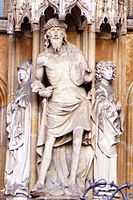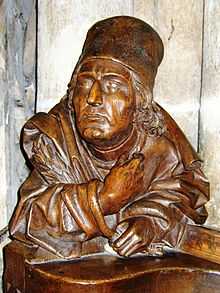Ulm Minster
| Ulm Minster | |
|---|---|
 | |
| Record height | |
| Tallest in the world from 1890 to 1901[I] | |
| Preceded by | Cologne Cathedral |
| Surpassed by | Philadelphia City Hall |
| General information | |
| Location | Ulm, Germany |
| Coordinates | 48°23′55″N 9°59′33″E / 48.39861°N 9.99250°ECoordinates: 48°23′55″N 9°59′33″E / 48.39861°N 9.99250°E |
| Construction started | 1377 |
| Completed | 31 May 1890 |
| Height | 161.5 m (530 ft) |
| Technical details | |
| Floor count | n/a |
| References | |
| [1] | |


Ulm Minster (German: Ulmer Münster, literally: minster) is a Lutheran church and former Roman Catholic church located in Ulm, Germany. Although sometimes referred to as Ulm Cathedral because of its great size, the church is not a cathedral as it has never been the seat of a bishop.
Ulm Minster, like Cologne Cathedral (Kölner Dom), was begun in the Gothic era and not completed until the late 19th century. It is the tallest church in the world,[2] and the 4th tallest structure built before the 20th century, with a steeple measuring 161.5 metres (530 ft)[2] and containing 768 steps. From the top level at 143 m (469 ft) there is a panoramic view of Ulm in Baden-Württemberg and Neu-Ulm in Bavaria and, in clear weather, a vista of the Alps from Säntis to the Zugspitze. The final stairwell to the top (known as the third Gallery) is a tall, spiraling staircase that has barely enough room for one person.
History and architecture
Construction
In the 14th century, the parish church of Ulm was located outside the walled city. The burghers of Ulm decided to erect a new church within the perimeters of the city and to finance the costs of the erection.
In 1377 the foundation stone was laid. The planned church was to have three naves of equal height, a main spire on the west and two steeples above the choir. In 1392 Ulrich Ensingen (associated with Strasbourg Cathedral) was appointed master builder. It was his plan to make the western church tower the tallest spire, which it remains in the present day.
The church, consisting of the longitudinal naves and the choir, covered by a temporary roof, was consecrated in 1405. However, structural damage, caused by the height of the naves and the weight of the heavy vaulting, necessitated a reconstruction of the lateral naves which were supported by a row of additional column in their centre.
In a referendum in 1530/31, the citizens of Ulm converted to Protestantism during the Reformation. Ulm Minster became a Lutheran church. Although as large as many cathedrals, Ulm is not a cathedral, as the responsible bishop of the Evangelical-Lutheran Church in Württemberg – member of the Evangelical Church in Germany – resides in Stuttgart.
In 1543 construction work was halted at a time when the steeple had reached a height of some 100 metres (330 ft). The halt in the building process was caused by a variety of factors which were political and religious (the Reformation, the Thirty Years' War, the War of the Spanish Succession) as well as economic (the discovery of the Americas in 1492 and of the sea route to India in 1497, leading to a shift in trade routes and commodities). One result was economic stagnation and a steady decline, preventing major public expenditure.
In 1817 work resumed and the three steeples of the church were completed. Finally, on 31 May 1890 the building was completed.
World War II
A devastating air raid hit Ulm on 17 December 1944, which destroyed virtually the entire town west of the church to the railway station and north of the church up to the outskirts. The church itself was barely damaged. However, almost all the other buildings of the town square (Münsterplatz) were severely hit and some 80% of the medieval centre of Ulm was destroyed.
Works of art
- Late medieval sculptures include the tympanum of the main Western entrance depicts scenes from the Genesis. The central column bears a sculpture, the Man of Sorrows, by the local master Hans Multscher.
- The 15th century choir stalls by Jörg Syrlin the Elder, made from oak and adorned with hundreds of carved busts are among the most famous pews of the Gothic period.
- The pulpit canopy is by Jörg Syrlin the Younger.
- The original main altar was destroyed by the iconoclasts of the Reformation. The current altarpiece from the early 16th century is a triptych, showing figures of the Holy Family and the Last Supper in the predella.
- The five stained glass windows of the apse, which is in the form of half a decagon, show biblical scenes and go back to the 14th and 15th century.
- The main organ of the church was destroyed by iconoclasts and replaced in the late 16th century. In 1763 Wolfgang Amadeus Mozart is known to have played it. For some decades it was the largest organ in existence. In the late 1960s it was reconstructed to solve acoustic problems of reverberation.
- In 1877, the Jewish congregation of the synagogue of Ulm - including Hermann Einstein, the father of Albert Einstein - donated money for a statue of the Biblical prophet Jeremiah. The figure was placed below the main organ.
- Later renovations in the modern era added gargoyles and a sculpture, The Beggar, by the expressionist Ernst Barlach.
Gallery: Works of art
-

Figures from Genesis above the main portal
-

Man of Sorrows on the main portal by Hans Multscher
-

Main altar by Martin Schaffner (1521)
-

The Visitation - Detail of the stained glass
-

Dragon gargoyle on the way up the stairs of the Ulmer Münster steeple
-
_-_2013.jpg)
The west end and organ
-

The choir stalls
-

Virgil by Jörg Syrlin t.E., possibly a self-portrait
-
„Ulmer Spatz“: the original of 1858 by the cathedral roof is now in the Ulmer Münster near the entrance in a display case.
Plan

- A. Entrance hall.
- B. Main porch.
- C. Tower hall.
- D. Nave.
- E. Aisles.
- F. Choir.
- G. Sacristy.
- H. Besserer Chapel.
- J. Reithart Chapel.
- K. High altar.
- L. Old tabernacle.
- M. Choir stalls.
- N. Tabernacle.
- O. Baptismal font.
- P. Holy-water font.
- Q. Side porches.
- R. Organ entrance.
- S. Pulpit.
Measurements
- The height of the steeple is 161.53 metres (530.0 ft). Ulm Münster is the world's tallest church
- The church has a length of 123.56 metres (405.4 ft) and a width of 48.8 metres (160 ft).
- The building area is approximately 8,260 square metres (88,900 sq ft).
- The height of the central nave is 41.6 metres (136 ft), whilst the lateral naves are 20.55 metres (67.4 ft) high.
- The volume of the edifice is some 190,000 cubic metres (6,700,000 cu ft).
- The weight of the main steeple is estimated at 51,500 tonnes (50,700 long tons; 56,800 short tons).
- The church seats a congregation of 2,000.
- In the Middle Ages, before pews were introduced, it could accommodate 20,000 people, when the population of the town was about 5000.
See also
- Strasbourg Cathedral
- Cologne cathedral
- Gothic Architecture
- Protestant Reformation
References
- ↑ Ulm Minster at Emporis
- ↑ 2.0 2.1 Oggins, R.O. (2000). "Cathedrals". Metrobooks. Friedman/Fairfax Publishers. Retrieved 6 October 2010.
External links
| Wikimedia Commons has media related to Ulm Minster. |
| Records | ||
|---|---|---|
| Preceded by Cologne Cathedral |
Tallest building in the world 1890–1901 161.5 m (530 ft) |
Succeeded by Philadelphia City Hall |
| Tallest Building in Europe 1890–1952 161.5 m (530 ft) |
Succeeded by Kotelnicheskaya Embankment Building | |
